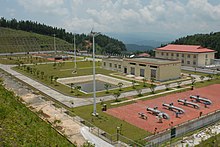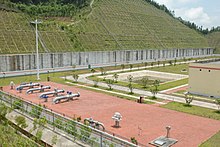Myanmar-China Pipelines
Type
Crude oil and natural gas pipelinesLocation
Myanmar and ChinaLength
Crude oil pipeline: 770.5km, gas pipeline: 793km (Myanmar section) and 1,727km (China section)Output
22 million tonnes of oil and up to 13 billion cubic metres of gas per yearThe Myanmar-China Pipelines project comprises of the construction of two separate, parallel pipelines for transporting crude oil and natural gas from Daewoo International’s offshore blocks A-1 and A-3 in Myanmar, to China.
The project was first proposed in 2004 and took a leap when China
National Petroleum Corporation (CNPC) signed a 30-year hydrocarbons
purchase and sale agreement with Daewoo International in December 2008.
"The gas pipeline enables CNPC to import natural gas to China, while also helping Myanmar to supply gas locally."
The pipelines will enable CNPC to import natural gas to China, while also helping Myanmar to supply gas locally.
CNPC’s subsidiary, Southeast Asia Crude Pipeline Company, was
assigned with the task of designing, constructing, operating and
maintaining the crude and gas pipelines in 2009.
Construction on the Myanmar section of the pipelines began in June
2010, while that on the Chinese section started about three months
later.
The gas pipeline was completed by May 2013, while the crude pipeline was 94% complete at that time.
The gas pipeline became fully operational in October 2013. The crude pipeline is expected to be completed by the end of 2013.
The estimated investment on the project is $2.54bn, including $1.5bn for the oil pipeline and $1.04bn for the gas pipeline.
Myanmar-China pipelines development
CNPC (50.9%) and Myanmar Oil and Gas Enterprise (MOGE, 49.1%) are
investing in the crude oil pipeline, where as CNPC, MOGE, Daewoo
International, KOGAS, Indian Oil and GAIL invested in the natural gas
pipeline.
The pipelines will reduce China’s energy import costs and diversify its import routes.
CNPC currently ships crude oil to China through the Strait of Malacca, which is controlled by the US.
The Myanmar-China crude pipeline will reduce the reliance on the
conventional shipping route and thus secure China’s energy security.
Route for the crude oil and natural gas pipelines
The gas pipeline is 2,520km long including the 793km Myanmar section and the 1,727km China section.
"The estimated investment on the project is $2.54bn, including $1.5bn for the oil pipeline and $1.04bn for the gas pipeline."
The pipelines start at Kyaukryu, on the west coast of Myanmar, where
an oil terminal was constructed. The crude oil pipeline begins at Maday
Island, whereas the gas pipeline begins at Ramree Island in Kyaukryu.
The pipelines run through the state of Rakhine, Magway, Mandalay and
state of Shan, before entering the Ruli region in the Yunnan province of
China.
The gas pipeline runs through Guizhou, Chongqing and Guangxi. The pipelines end at Kunming, the capital city of Yunnan province.
The crude pipeline will carry the crude oil that CNPC imports from Africa and the Middle East into China, via Myanmar.
The natural gas pipeline has a capacity to transport up to 13 billion
cubic metres of gas per year. It reduces the coal consumption by 30.72
million tonnes and CO2 emissions by 52.83 million tonnes.
Myanmar-China pipelines design
The crude oil pipeline is designed to carry approximately 22 million tonnes of oil per annum.
The design capacity of the natural gas pipeline is 13 billion cubic
metres. It is expected to deliver 12 billion m³ of gas to China every
year, while reserving one billion m³ of gas for Myanmar’s domestic use.
Offshore source and pipeline infrastructure
The gas pipeline from Myanmar to China carries the gas extracted from
Shwe gas project located offshore of the Bay of Bengal. The Shwe gas
project is owned by a joint venture between Daewoo International, ONGC
Videsh, MOGE, GAIL and Korea Gas Corp.
The associated infrastructure built for the Myanmar-China pipelines
includes a 300,000t crude oil wharf in Beijing and a 650,000m³ reservoir
at Maday Island for storage of water. The reservoir is the main source
of water for the pipeline operation.
Contractors involved with the Myanmar-China pipelines project
China Petroleum ZhongZhou Engineering Project Management, a
subsidiary of RH Energy, was awarded the pipeline inspection contract in
September 2011.
The scope of the contract includes provision of engineering inspection to the Guangxi section of the pipeline.
Schneider Electric was awarded a contract in May 2013 to provide an
engineering station control system for monitoring and managing the
pipeline operations.
As part of the contract Schneider Electric will supply its OASyS enterprise control and monitoring system.
Shengli Oil & Gas Pipe Holdings is the supplier of pipes for the pipeline.
Sino-Myanmar pipelines
Sino-Myanmar crude oil pipeline 
A sub-pumping station of Sino-Myanmar pipelines in Longling County, Yunnan ProvinceLocation Country Myanmar, China General direction south–north From Kyaukphyu Passes through Mandalay, Lashio, Muse, Ruili To Kunming Runs alongside Sino–Myanmar natural gas pipeline General information Type oil Partners China National Petroleum Corporation
Myanma Oil and Gas EnterpriseTechnical information Length 771 km (479 mi) Maximum discharge 240 thousand barrels per day (38×103 m3/d)
Sino-Myanmar pipelines refers to planned oil and natural gas pipelines linking Myanmar's deep-water port of Kyaukphyu (Sittwe) in the Bay of Bengal with Kunming in Yunnan province of China.Sino-Myanmar natural gas pipeline 
A sub-pumping station of Sino-Myanmar pipelines in Longling County, Yunnan ProvinceLocation Country Myanmar, China General direction south–north From Kyaukphyu Passes through Mandalay, Lashio, Muse, Ruili, Kunming To Guizhou and Guangxi Runs alongside Sino–Myanmar crude oil pipeline General information Type natural gas Partners China National Petroleum Corporation
Myanma Oil and Gas EnterpriseTechnical information Length 2,806 km (1,744 mi) Maximum discharge 12 billion cubic meters per year
Contents
History
Talks between China and Myanmar on the feasibility of the project began in 2004. In December 2005, PetroChina signed a deal with Myanmar's Government to purchase natural gas over a 30-year period.[1] Based on this agreement, the parent company of PetroChina, China National Petroleum Corporation (CNPC), signed on 25 December 2008 a contract with the Daewoo International-led consortium to purchase natural gas from the Shwe gas field in A-1 offshore block.[2]
The plan to build the oil and gas pipelines was approved by China's National Development and Reform Commission in April 2007.[3] In November 2008, China and Myanmar agreed to build a US$1.5 billion oil pipeline and US$1.04 billion natural gas pipeline. In March 2009, China and Myanmar signed an agreement to build a natural gas pipeline, and in June 2009 an agreement to build a crude oil pipeline.[4] The inauguration ceremony marking the start of construction was held on 31 October 2009 on Maday Island.[5][6]
The Myanmar section of the gas pipeline was completed on 12 June 2013 and gas started to flow to China on 21 October 2013.[7][8][9] The oil pipeline was completed in Aug, 2014.[10]
Route
The oil and natural gas pipelines run in parallel and start near Kyaukphyu, run through Mandalay, Lashio, and Muse in Myanmar before entering China at the border city of Ruili in Yunnan province.[11][12] The oil pipeline, which eventually terminates in Kunming, capital of Yunnan province, is 771 kilometres (479 mi) long.[6] The natural gas pipeline will extend further from Kunming to Guizhou and Guangxi in China, running a total of 2,806 kilometres (1,700 mi).[12]
Description
The oil pipeline will have a capacity of 12 million tonnes of crude oil per year.[13] It would diversify China's crude oil imports routes from the Middle East and Africa, and avoid traffic through the Strait of Malacca.[12][14] Oil storage tanks will be built on an island near the port of Kyaukphyu.[15] For oil processing China will build refineries in Chongqing, Sichuan, and in Yunnan.[16]
The gas pipeline will allow delivery of natural gas from Burma's offshore fields to China with an expected annual capacity of up to 12 bcm of natural gas.[12][17] The pipeline will be supplied from the A-1 and A-3 Shwe oil field.[18] China would start receiving natural gas from Burma's Shwe project through the pipeline in April 2013.[19] The Shwe, Shwe-Phyu, and Mya areas in the A-1 and A-3 blocks, estimated to hold 127–218 bcm of natural gas in total, are operated by a group led by Daewoo International Corp.[19] The operators group also includes Myanma Oil and Gas Enterprise, GAIL, and Korea Gas Corporation.
The total project of pipelines is expected to cost US$2.5 billion.[15]
In July 2014 CNPC celebrated the first anniversary of the launch of the Myanmar-China natural gas pipeline by announcing that nearly two billion cubic metres of gas has been piped from Indian Ocean plays onto the Asian continent.[20]
A railway that will connect Muse and Lashio is part of the project. The railway will be 80 miles long and will include 41 bridges, 36 underground tunnels and 7 stations.[21]
Controversy
A number of protests in Burma and abroad took place against the construction of the pipeline.[22] The pipelines have sparked protests over environmental and safety concerns, and inadequate compensation arrangements for local residents. Critics have also said the contract, which was signed under the military regime, should be revisited and that Burma should not be exporting gas when three-quarters of the population lack electricity.[9]
Operating company
The project will be implemented jointly by China National Petroleum Corporation (CNPC) and Myanma Oil and Gas Enterprise (MOGE). CNPC will hold a 50.9% stake and manage the project, and MOGE will own the rest.[15]
Further reading
- "The Geopolitics of the Myanmar-China Oil and Gas Pipelines," by Bo Kong, Pipeline Politics in Asia: The Intersection of Demand, Energy Markets, and Supply Routes, (National Bureau of Asian Research, 2010)
References
- Storey, Ian (2006-04-12). "China's "Malacca Dilemma"". China Brief. Jamestown Foundation. 6 (8). Retrieved 2008-11-21.
- "Daewoo seals Myanmar-China gas export deal - Xinhua". Reuters. 2008-12-25. Retrieved 2009-11-07.
- "China, Burma Still Discussing Proposed Pipeline". Downstream Today. 2008-03-10. Retrieved 2008-03-11.
- "Sino-Myanmar Crude Pipeline Memo Signed". Downstream Today. 2009-06-19. Retrieved 2009-07-18.
- "China starts building Burma pipeline". Upstream Online. NHST Media Group. 2009-11-03. Retrieved 2009-11-07.
- "China starts building Myanmar pipeline". Xinhua. Downstream Today. 2009-11-03. Retrieved 2009-11-07.
- "Burma Gas Pipeline Complete but Cites China Delays". the irrawaddy. 2013-06-12. Retrieved 2013-06-14.
- "BChina-Myanmar Gas Pipeline: Myanmar Once Again Getting A Bad Bargain In Chinese Investment". international business times. 2013-10-22. Retrieved 2014-05-14.
- Shin, Aung (27 October 2013). "Controversial pipeline now fully operational". The Myanmar Times. Retrieved 31 October 2013.
- "China-Myanmar joint pipeline starts delivering gas". CCTV.com. 2014-06-08. Retrieved 2014-11-11.
- Watkins, Eric (2008-11-20). "Myanmar awards China pipeline rights". Oil & Gas Journal (requires subscription). Retrieved 2008-12-05.
- "Construction of Sino-Myanmar oil-and-gas pipelines to begin in Sept". Global Times. 2009-06-17. Retrieved 2009-06-17.
- Boot, William (2009-11-06). "Weekly Business Roundup (November 7, 2009). China Confirms its Plan to use Burma as a Mideast Oil Conduit". The Irrawaddy. Retrieved 2009-11-07.
- Jenkins, Graeme (2008-01-16). "Burmese junta profits from Chinese pipeline". London: Telegraph. Retrieved 2008-07-20.
- "China, Myanmar to Build $2.5 Billion Pipelines, Nikkei Says". Bloomberg. 2008-11-17. Retrieved 2008-11-18.
- "China To Build Refineries for Oil from Burma Pipeline". Downstream Today. 2009-06-25. Retrieved 2009-07-18.
- "Construction of Sino-Myanmar O&G Pipelines to Begin in Sept". Downstream Today. 2009-06-16. Retrieved 2009-07-18.
- "India and China Compete for Burma's Resources". World Politics Review. 2006-08-21. Retrieved 2008-11-21.
- "China May Start Receiving Myanmar Gas Through Pipeline in 2013". Bloomberg. 2009-03-10. Retrieved 2009-03-10.
- http://www.oilandgastechnology.net/pipeline-news/myanmar-china-pipeline-ships-187bn-cubic-metres-gas
- http://www.mizzima.com/business/5212-burma-china-sign-railway-pact-to-transport-gas.html



No comments:
Post a Comment